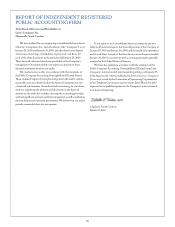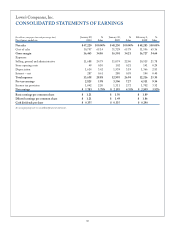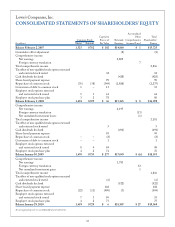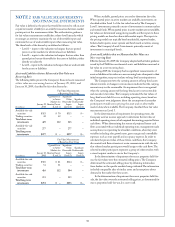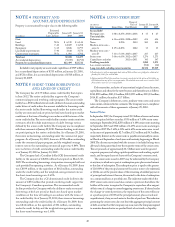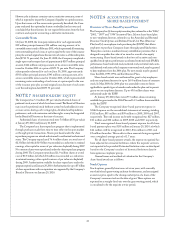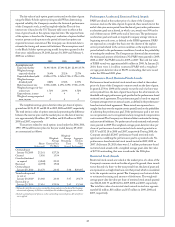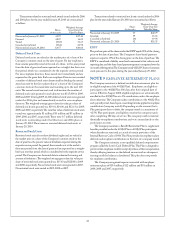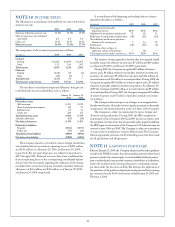Lowe's 2009 Annual Report Download - page 37
Download and view the complete annual report
Please find page 37 of the 2009 Lowe's annual report below. You can navigate through the pages in the report by either clicking on the pages listed below, or by using the keyword search tool below to find specific information within the annual report.
35
Derivative Financial Instruments – e Company occasionally
utilizes derivative financial instruments to manage certain business
risks. However, the amounts were not material to the Company’s
consolidated financial statements in any of the years presented.
e Company does not use derivative financial instruments for
trading purposes.
Credit Programs – e majority of the Company’s accounts
receivable arises from sales of goods and services to Commercial
Business Customers. e Company has an agreement with GE Money
Bank (GE) under which GE purchases at face value new commercial
business accounts receivable originated by the Company and services
these accounts. is agreement ends in December 2016, unless terminated
sooner by the parties. e Company accounts for these transfers as sales
of the accounts receivable. When the Company sells its commercial
business accounts receivable, it retains certain interests in those receivables,
including the funding of a loss reserve and its obligation related to
GE’s ongoing servicing of the receivables sold. Any gain or loss on
the sale is determined based on the previous carrying amounts of the
transferred assets allocated at fair value between the receivables sold
and the interests retained. Fair value is based on the present value of
expected future cash flows, taking into account the key assumptions
of anticipated credit losses, payment rates, late fee rates, GE’s servicing
costs and the discount rate commensurate with the uncertainty involved.
Due to the short-term nature of the receivables sold, changes to the
key assumptions would not materially impact the recorded gain or loss
on the sales of receivables or the fair value of the retained interests in
the receivables.
Total commercial business accounts receivable sold to GE were
$1.6 billion in 2009, $1.7 billion in 2008, and $1.8 billion in 2007. During
2009, 2008 and 2007, the Company recognized losses of $31 million,
$38 million and $34 million, respectively, on these receivable sales as
SG&A expense, which primarily relates to the fair value of the obliga-
tions incurred related to servicing costs that are remitted to GE monthly.
At January 29, 2010 and January 30, 2009, the fair value of the retained
interests was determined based on the present value of expected future
cash flows and was insignificant.
Sales generated through the Company’s proprietary credit cards
are not reflected in receivables. Under an agreement with GE, credit
is extended directly to customers by GE. All credit-program-related
services are performed and controlled directly by GE. e Company
has the option, but no obligation, to purchase the receivables at the
end of the agreement in December 2016. Tender costs, including
amounts associated with accepting the Company’s proprietary credit
cards, are recorded in SG&A expense in the consolidated statements
of earnings.
e total portfolio of receivables held by GE, including both
receivables originated by GE from the Company’s proprietary credit
cards and commercial business accounts receivable originated by the
Company and sold to GE, approximated $6.5 billion at January 29,
2010, and $6.8 billion at January 30, 2009.
Property and Depreciation – Property is recorded at cost. Costs
associated with major additions are capitalized and depreciated.
Capital assets are expected to yield future benefits and have useful lives
which exceed one year. e total cost of a capital asset generally includes
all applicable sales taxes, delivery costs, installation costs and other
appropriate costs incurred by the Company including interest in the
case of self-constructed assets. Upon disposal, the cost of properties
and related accumulated depreciation are removed from the accounts,
with gains and losses reflected in SG&A expense on the consolidated
statements of earnings.
Depreciation is provided over the estimated useful lives of the
depreciable assets. Assets are depreciated using the straight-line method.
Assets under capital lease and leasehold improvements are depreciated
over the shorter of their estimated useful lives or the term of the
related lease, which may include one or more option renewal periods
where failure to exercise such options would result in an economic
penalty in such amount that renewal appears, at the inception of the
lease, to be reasonably assured. During the term of a lease, if leasehold
improvements are placed in service significantly after the inception of
the lease, the Company depreciates these leasehold improvements over
the shorter of the useful life of the leasehold assets or a term that includes
lease renewal periods deemed to be reasonably assured at the time the
leasehold improvements are placed into service. e amortization of
these assets is included in depreciation expense on the consolidated
financial statements.
Long-Lived Asset Impairment/Exit Activities – e carrying
amounts of long-lived assets are reviewed whenever events or changes in
circumstances indicate that the carrying amounts may not be recoverable.
Long-lived assets held-for-use includes operating stores as well
as excess properties, such as relocated stores, closed stores and other
properties, which do not meet the held-for-sale criteria. A potential
impairment has occurred for long-lived assets held-for-use if projected
future undiscounted cash flows expected to result from the use and
eventual disposition of the assets are less than the carrying amounts
of the assets. An impairment loss is recorded for long-lived assets
held-for-use when the carrying amount of the asset is not recoverable
and exceeds its fair value.
Excess properties that are expected to be sold within the next 12
months and meet the other relevant held-for-sale criteria are classified
as long-lived assets held-for-sale. An impairment loss is recorded for
long-lived assets held-for-sale when the carrying amount of the asset
exceeds its fair value less cost to sell. A long-lived asset is not depreciated
while it is classified as held-for-sale.
For long-lived assets to be abandoned, the Company considers the
asset to be disposed of when it ceases to be used. Until it ceases to be
used, the Company continues to classify the asset as held-for-use and
tests for potential impairment accordingly. If the Company commits
to a plan to abandon a long-lived asset before the end of its previously
estimated useful life, its depreciable life is re-evaluated.
Impairment losses are included in SG&A expense. e Company
recorded long-lived asset impairment losses of $114 million during 2009,
including $53 million for operating stores and $61 million for excess
properties. e Company recorded long-lived asset impairment losses of
$21 million during 2008, including $16 million for operating stores and
$5 million for excess properties. e Company recorded long-lived asset
impairment losses of $28 million during 2007 for excess properties.
e net carrying amount of excess properties that do not meet the
held-for-sale criteria is included in other assets (non-current) on the
consolidated balance sheets and totaled $205 million and $174 million
at January 29, 2010 and January 30, 2009, respectively.
When operating leased locations are closed, a liability is recognized
for the fair value of future contractual obligations, including future
minimum lease payments, property taxes, utilities and common area
maintenance, net of estimated sublease income.





